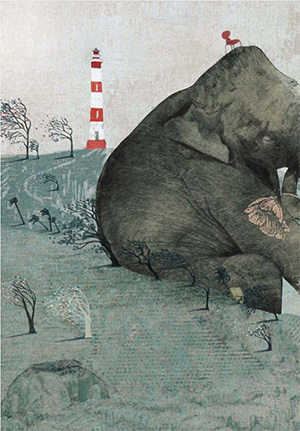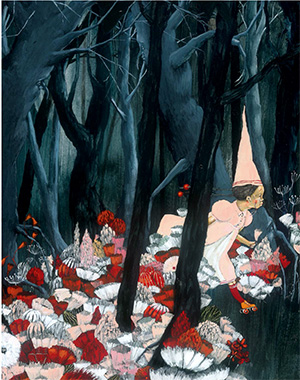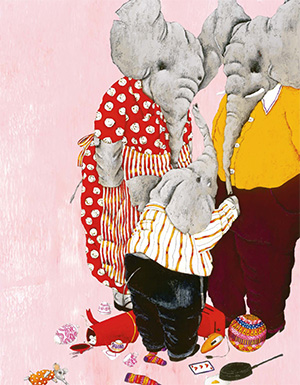Diversity in design for children’s books
Children’s books are a popular Dutch and Flemish export product. Just think of Annie M.G. Schmidt’s famous Jip en Janneke stories that started travelling the world almost immediately after publication. The two children are called Janó en Janka in Hungarian, Jaś and Janeczka in Polish, Jan and Janeke in Ukrainian, Saša and Maša in Russian.
What caught my eye, when I first read the stories, was the design. The clear lines and black silhouettes made by Fiep Westerdorp are universally known. The Netherlands is also the birth land of another famous designer for children’s books: Dick Bruna, the father of Nijntje (Miffy in German, Spanish, English and other languages, Kleintjie in Afrikaans. With a few simple lines and a ‘bibber’ (a shiver) as Bruna explained in an interview, he manages to create a whole world.
In Romania, neither Jip and Janneke nor Nijntje are translated, but that does not mean that Dutch language children’s literature is not present. On the contrary, publishing house Signatura based in Cluj has quite a diverse and impressive collection. Bianca Mereuță had a boring job in marketing before she decided to quit everything, get a loan and start her own publishing house. Her motivation was the lack of quality books for children in Romania. Bianca not only runs Signatura, she is also the founder of the association Versus, and of an incredibly famous Facebook Group called “Ce le citim copiilor?” (What do we read to our children?), with affiliated groups in the Romanian diaspora all across the world. In total more than 150.000 members, in Romania alone, that consists of mothers, fathers, aunts, uncles and a lot of kids, follow her recommendations. Bianca wants to bring books in the world that promote kindness, love and mutual understanding.

Mannetje and vrouwtje krijgen een kind (Little man and little woman) - text Brigitte Minne, illustration Kaatje Vermeire
I got an email from Bianca in July 2019, asking if I would be interested to translate two books De gouden kooi (The Golden Cage) written by Anna Castagnoli and illustrated by Carll Cneutt and Mannetje en vrouwtje krijgen een kind (Little man and little woman) with a text by Brigitte Minne and illustration by Kaatje Vermeire. Bianca wrote: “I want books so beautiful and with messages so powerful and that take you to the depths of your being, that they make as many of those who encounter them want them.” And these books are exactly that. I loved these strange stories and we ended up translating seven books in total, frequently talking on the phone about the specificity of one word or the implication of another word. They are all of a beautiful diversity, all published at the Flemish publisher De Eenhoorn.

De vraag van de olifant (illustration Kaatje Vermeire, text Leen van den Berg)
The design of a lot of Bianca’s chosen books is made by Carll Cneut, the famous Flemish artist, who has won practically all important design prizes in The Netherlands and Belgium. His drawings are original, exuberant, full of details, slightly grotesque and always thrilling. On the Signatura’s website, you can find not only information of the plot of the book, but also a wide description of its design. For example, about De gouden kooi (The Golden Cage):
“The illustrations are an array of images of birds depicted in strong, vivid colours and shades; in contrasts such as green-black, yellow-black, grey-black or red-black. Textually we see a juxtaposition of styles that mark two different tones in the reading. On the one hand we have a neutral spelling that marks the objective narrative voice. And on the other hand, there is a handwriting that imitates handwriting and records Valentina's words or makes direct reference to her [the main character].”
That illustrates the importance of the design for this Romanian publisher. Another illustrator that Bianca Mereuță chose is Kaatje Vermeire, another acclaimed Flemish illustrator, with a delicate, somewhat naïve and very strong style. Vermeire speaks about her technique in an interview, saying: “I try to suggest/evoke worlds different from those that are described in the texts. By adding little details, inventing new characters that aren’t present in the text, including humour now and then, I want to create an atmosphere full of little channels to escape into… For children as well as for adults. Lightness on the surface, but deepness behind… If you take a good look.”


Heksenfee (illustration Carll Cneut, text: Brigitte Minne)

Een miljoen vlinders (illustration Carll Cneut, text Edward van de Vendel)
Not only was Bianca Mereuță interested in the kindness of these stories and the quality of the design, she was also very careful with the printing. The costs involved are high, but Bianca has total commitment and wants to invest: “Publishing a quality book in Romania is a matter of total commitment and of faith in education”. For the book Heksenfee (Witchfairy text Brigitte Minne, illustration Carll Cneut), Bianca even entered a competition by the global paper manufacturer Antalis, that she won, which gave her the financial means to publish the book at a high quality. One of her main goals is to educate the Romanian public also from a visual point of view. These designs speak of a very special fragility. Through these books, the young readers (and their parents) learn to appreciate design as being part of the story, not only complementary to it. Check the website Signatura and the Instagram account where you can find Bianca promoting her books and explaining patiently what her books are all about.
(Alexa Stoicescu)
